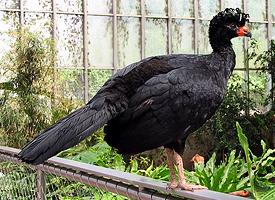
Váhy a míry
| Výška v kohoutku | od 80 do 90 cm |
|---|---|
| Hmotnost | 2,5 kg |
Popis zvířete
The Wattled Curassow (Crax globulosa) is a striking and distinctive bird that belongs to the Cracidae family, which also includes guans and chachalacas. Native to the tropical rainforests of South America, particularly in regions around the Amazon Basin, this species is noted for its unique appearance and behaviors.Adults of the species typically exhibit a predominantly black plumage that gleams with an iridescent sheen under sunlight, showcasing hues of blue and green. This glossy appearance is complemented by a white vent and undertail coverts, which contrast sharply with the rest of the body. A distinguishing feature of the Wattled Curassow is its remarkable wattle, a fleshy, bulbous structure that dangles from the base of the beak, more prominent and colorful in males than in females. The bird's head is adorned with a crest of curled feathers that can be raised or lowered, adding to its distinguished look. The beak is strong and hooked, designed for its omnivorous diet.
Reaching up to 90 cm in length and weighing around 3.5 kg, the Wattled Curassow is among the larger bird species within its habitat. Males are generally larger than females and exhibit more vibrant coloration, a common trait in the avian world known as sexual dimorphism.
The habitat of the Wattled Curassow is primarily the dense, humid rainforests and swamps near rivers and streams. They are highly dependent on these aquatic environments, not only for nesting near the water's edge but also for their diet, which includes a variety of fruits, seeds, and occasionally small animals such as insects and fish.
Wattled Curassows are ground dwellers but roost in trees at night. They are known to be quite secretive and elusive, making them difficult to observe in their natural habitat. Their calls, a series of low-pitched, mournful notes, often reveal their presence before they are seen.
Reproduction for the Wattled Curassow involves a solitary nest built on the ground or slightly elevated in dense thickets or fallen tree branches. The female typically lays two to three eggs, which she incubates alone, while the male guards the territory against potential threats.
Unfortunately, the Wattled Curassow is classified as Critically Endangered by the International Union for Conservation of Nature (IUCN). Its population has been declining rapidly due to a combination of habitat destruction, especially from deforestation and development, and overhunting for its meat and feathers. Conservation efforts are underway to protect this magnificent bird, including habitat preservation, anti-poaching measures, and breeding programs aimed at increasing its population and reintroducing it into areas where it has been extirpated.
The Wattled Curassow represents a critical component of its ecosystem, playing a role in seed dispersal and the maintenance of forest diversity. Its plight highlights the broader challenges facing the Amazon rainforest and its inhabitants, underscoring the importance of conservation efforts in preserving the biodiversity of one of the planet's most vital ecological regions.
Nové fotografie zvířat
Top 10 zvířat
- Chinese water dragon (Physignathus cocincinus)
- Galápagos tortoise (Geochelone nigra complex)
- Dolphin gull (Leucophaeus scoresbii)
- Japanese macaque (Macaca fuscata)
- Colombian red howler (Alouatta seniculus)
- Sea urchins (Echinoidea)
- Moustached guenon (Cercopithecus cephus)
- Diana monkey (Cercopithecus diana)
- Common reed warbler (Acrocephalus scirpaceus)
- Common house mosquito (Culex pipiens)